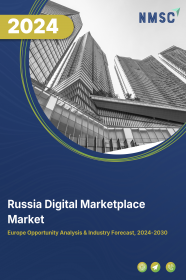
Russia Digital Marketplace Market by Product/Service Type (Physical Goods, Digital Goods, Services, and Event & Ticket Sales), by Platform (Desktop, Mobile, and Tablets), by Model Type (Business to Business (B2B), Business to Consumer (B2C), and Consumer to Consumer (C2C)), and by End Users (Commercial, and Personal) - Opportunity Analysis and Industry Forecast, 2024 – 2030
Industry: ICT & Media | Publish Date: 09-Oct-2025 | No of Pages: 159 | No. of Tables: 120 | No. of Figures: 65 | Format: PDF | Report Code : IC2248
Russia Digital Marketplace Market Overview
The Russia Digital Marketplace Market size was valued at USD 4.65 billion in 2023, and is predicted to reach USD 5.60 billion by 2030, at a CAGR of 2.5% from 2024 to 2030. Digital marketplace market, also known interchangeably as online marketplaces or digital commerce platforms, function as virtual hubs where individuals engage in transactions involving the purchase or sale of goods, services, or information. These platforms serve as intermediaries, facilitating transactions between various parties, including buyers and sellers, within a centralized online environment specifically designed for effortless product discovery, purchasing, and delivery. Prominent examples of online marketplaces include well-established e-commerce platforms such as Amazon, eBay, and Alibaba, as well as service-oriented platforms such as Upwork and Fiverr.
Utilizing sophisticated technology, these platforms streamline transaction processes, ensuring prompt and secure payment processing while safeguarding the financial data of all involved parties. Moreover, they enhance user experiences by offering features such as customer reviews, ratings, and mechanisms for resolving transaction-related issues. Consequently, online marketplaces leverage technology to enhance the overall online shopping experience, making it more convenient and secure for both buyers and sellers. They play an indispensable role in the modern economy by bridging the gap between businesses and consumers across different geographic locations, thereby enabling seamless and convenient global commerce.
Regional Sales Boom And Rising Export Opportunities Accelerate Marketplace Expansion
The expansion of Russia’s digital marketplaces is increasingly driven by rapid growth in regional sales. Consumers outside of major metropolitan areas are becoming highly active participants in online commerce, as platforms improve delivery networks and adapt product offerings to local demand. This regional surge is not only broadening the customer base but also ensuring more balanced nationwide growth in the digital economy. Alongside domestic momentum, Russian marketplaces are increasingly pursuing cross-border opportunities by exporting to neighboring countries and select international markets. Categories such as household goods, food products, cosmetics, and building materials are gaining traction in overseas sales, positioning Russian platforms as emerging competitors in the global e-commerce landscape.
Advancements In Payment Systems And Digital Infrastructure Enhancing Consumer Trust
Another key driver of marketplace growth in Russia is the continued improvement of digital infrastructure and payment systems. The widespread adoption of mobile and cashless transactions, along with the increasing use of domestic payment networks, is making online purchases more seamless and reliable for consumers. At the same time, higher levels of digital literacy are empowering new segments of the population, including those in previously underserved regions, to engage with online marketplaces confidently. These developments not only reduce friction in the transaction process but also build stronger trust between buyers and sellers. As a result, digital platforms are evolving into secure and dependable spaces for everyday shopping, further embedding them into consumer lifestyles.
Sanctions-induced Supply Chain & Payment Infrastructure Disruptions Hinder Marketplace Operations
The ongoing international sanctions and trade restrictions are creating serious bottlenecks in key areas of marketplace operations. Restrictions on importing electronics, semiconductors, and foreign software limit access to advanced hardware and technologies, forcing marketplace platforms to rely on less efficient or domestically developed substitutes. This can lead to delays in deployment of features, poorer performance, and higher operating costs.
In parallel, constraints on cross-border payments, tightening of compliance requirements by foreign banks, and restricted use of international payment networks have elevated transaction costs and complicated financial interactions for both sellers and buyers. These disruptions increase uncertainty, reduce margins, and can discourage foreign sellers or suppliers from participating. The result is that growth potential is dampened by structural barriers in supply of components, tools, and reliable payment flows.
Localization & Domestic Brand Development As A Strategic Advantage
There is growing momentum behind efforts to promote goods produced in Russia, and this creates a strong opportunity for digital marketplaces to deepen their local supply chains and elevate domestic brands. Policies that favour “Made in Russia” labelling, regional showcases, preferential display of Russian products on platform search results, and support for local manufacturers are increasing.
By collaborating with regional producers and small and medium-sized businesses, marketplaces can build trust among consumers who increasingly prefer locally made goods both for reasons of patriotism, quality perception, and shorter delivery times. Moreover, marketplaces that help local brands with localization support—such as design adaptation, regulatory compliance, packaging, and logistics—can differentiate themselves. This approach also helps reduce dependency on imports, which is particularly valuable given global supply chain disruptions and trade restrictions.
Competitive Landscape
The key market players operating in the Russia digital marketplace industry include Wildberries, Ozon, Yandex.Market, AliExpress Russia, SberMegaMarket, Lamoda, M.Video, Citilink, VseInstrumenty.ru, Emex, DNS (DNS-Shop.ru), Avito, Auto.ru, SberMarket, Delivery Club, and others.
Russia Digital Marketplace Market Key Segments
By Product/Service Type
-
Physical Goods
-
Electronics
-
Clothing
-
Food
-
Furniture
-
Handbag & Accessories
-
Others
-
-
Digital Goods
-
Software
-
E-Books
-
Music & Videos
-
Games
-
-
Services
-
Freelancing
-
Education
-
Consultations
-
Others
-
-
Event & Ticket Sales
By Platform
-
Desktop
-
Mobile
-
Tablets
By Model Type
-
Business To Business (B2b)
-
Business To Consumer (B2c)
-
Consumer-To-Consumer (C2c)
By End User
-
Commercial
-
Personal
Key Players
-
Wildberries
-
Ozon
-
Yandex.Market
-
AliExpress Russia
-
SberMegaMarket
-
Lamoda
-
M.Video
-
Citilink
-
VseInstrumenty.ru
-
Emex
-
DNS (DNS-Shop.ru)
-
Avito
-
Auto.ru
-
SberMarket
-
Delivery Club
REPORT SCOPE AND SEGMENTATION:
|
Parameters |
Details |
|
Market Size in 2023 |
USD 4.65 Billion |
|
Revenue Forecast in 2030 |
USD 5.60 Billion |
|
Growth Rate |
CAGR of 2.5% from 2024 to 2030 |
|
Analysis Period |
2023–2030 |
|
Base Year Considered |
2023 |
|
Forecast Period |
2024–2030 |
|
Market Size Estimation |
Billion (USD) |
|
Growth Factors |
|
|
Companies Profiled |
15 |
|
Market Share |
Available for 10 companies |
|
Customization Scope |
Free customization (equivalent up to 80 working hours of analysts) after purchase. Addition or alteration to country, regional, and segment scope. |
|
Pricing and Purchase Options |
Avail customized purchase options to meet your exact research needs. |

















 Speak to Our Analyst
Speak to Our Analyst
























